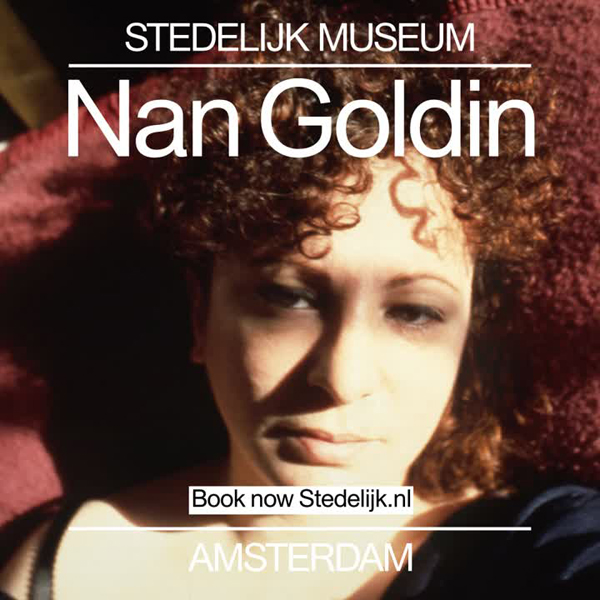A blog about (hidden) Amsterdam
A blog about (hidden) Amsterdam
Stop what you’re doing and book a ticket to see Nan Goldin’s exhibition at Amsterdam’s Stedelijk Museum before it closes on January 28. The iconic photographer’s work is most closely associated with New York, but Amsterdammers feel like her perfect audience.
When they hear I moved from New York City, Amsterdammers often remind me that New York was originally New Amsterdam. At first, Amsterdam’s three-story red brick facades and clean(ish) canals felt far more than an ocean away from NYC’s broken-down subway and canyons of skyscrapers. However, I’ve discovered the cities do resonate.
You meet people in each city that you’d never find anywhere else. Both cities flourished through worldwide immigration, with communities mixing but not quite merging. Both have a thriving scene of indie artists and major shows, though the Dutch Museum Card means I see much more here than an artist in New York could ever afford. And both cities are dealing with rapid change by idealizing an earlier Bohemian era that was far more challenging than its current image suggests.
These traits come together – along with so many other themes – in This Will Not End Well, a major exhibit currently at Amsterdam’s modern art museum. Nan Goldin made her name with a cycle of photos called The Ballad of Sexual Dependency that portrayed NYC’s underground punk and queer arts scene in the 1980s. Goldin photographed her friends and lovers in extreme moments and in the everyday. Even at the time, the image she portrayed was not some Bohemian fantasyland, but one with shadows and knives. Pictures of charismatic beauties and wild parties lay alongside images of domestic violence and drug abuse.
As she continued to photograph across decades, her photos remained as compelling as they were unsparing. Whether Goldin is in them or not, they are incredibly intimate, more honest than most diaries ever manage to be. For some photographers, the camera is distancing, allowing us and them to view something at a remove. Goldin takes us in, experiencing each scene with her, and she is not an observer but one of the subjects.
What makes this exhibition so stunning is how the images are recontextualized to let us see new things. She created six themed slide shows, each with a soundtrack and space to experience them that are both perfectly designed to heighten and contrast. There is no set order, so how you first see an image is shaped by how much you walk in knowing and how much she tells us through its context and soundtrack.
Some images repeat in multiple slideshows, changing their meaning as they do. A glamourous woman enjoying a night out in The Ballad of Sexual Dependency becomes an image of a young girl’s savior in Sisters, Saints, and Sibyls. When this same photo appeared in The Other Side, Goldin’s homage to her transgender friends, it gave another layer to both appearances. Again and again, seeing images in different ways challenges assumptions even as it tells new stories.
Underneath it all, Goldin explores the duality of harm and happiness, the way our most fundamental human experiences can twist for good or ill. She explores the deep harm that can come from a lover, a sister, a mother. Like the Bohemian world she first photographed, Western culture often puts these relationships on a pedestal, creating an image of safety. Goldin’s slideshows explore the extremes of both, placing the ecstasy of sex and the joy of parenthood alongside unflinching portrayals of domestic violence and child abuse.
There is a challenge to an installation that unthreads so many myths. Her stark eye confronts many inconsistencies we learn to ignore. The experience, however, is a mesmerizing one. The afternoon I went, I saw young teens and retirees sit rapt for multiple showings of the same slideshow, despite the roughly 20-minute length of each. I’m planning to go back at least one more time before it closes, sure that I will see so much more with each viewing.
Nan Goldin is currently leading a wildly successful campaign to get museums to divest from the Sackler family, which made millions in America’s opioid crisis through bribing doctors and misleading the public about their drug’s addictive properties. In December of 2023, she was named the most influential person in the art world by ArtReview. Between her groundbreaking art and effective activism, it would be hard to estimate how many people she has reached.
With images from across Nan Goldin’s legendary career, This Will Not End Well is a stunning work that spans decades and explores some of the most difficult questions of modern human life while celebrating the things that keep us moving.

Check out some more Blamsterdam! posts.
Private Museum Tour
See the highlights and hidden icons of Amsterdam’s world-renowned Rijksmuseum in a private guided tour that explores who creates art and what stories it’s used to tell. And don’t worry about museum tickets. We’ve got you covered.


Small-Group Walking Tour
This historical tour through the busy Jewish quarter and residential Plantage neighborhood offers a selection of stories from BIPOC, LGBTQ+, Jewish and women’s history. It’s the perfect way to get an alternative view of Amsterdam.


Self-Guided Digital Tour
Use your phone to explore Amsterdam! This self-guided tour uses audio, images, maps, and text to introduce you to the women, BIPOC, LGBTQ+, and Jewish people who made Amsterdam what it is.


Small-Group Walking Tour
In 1593, Jewish Amsterdammers began building a community in the relative safety of the city that transformed both the Netherlands and the world. Learn about these creative, compassionate, and challenging mavericks and their impact.


Small-Group Walking Tour
The women who shaped Amsterdam are more complex than traditional tours would have you believe. Go to Amsterdam’s historic sites to hear stories of women who fought, wrote, calculated and led through the city’s chaotic and complicated past.


Small-Group Walking Tour
The world’s first gay marriage was officiated by the Mayor of Amsterdam at its City Hall. But did you know that the city’s LGBTQ+ history stretches centuries? Meet historical Amsterdammers across the gender spectrum and sexual orientations.


Private Walking Tour
Get a personalized tour that covers the interests you’re curious about and the neighborhoods you want to see. Choose pick-up/drop-off locations, any combination of our hidden history topics, and themes such as artists, politicians, and rebels.

